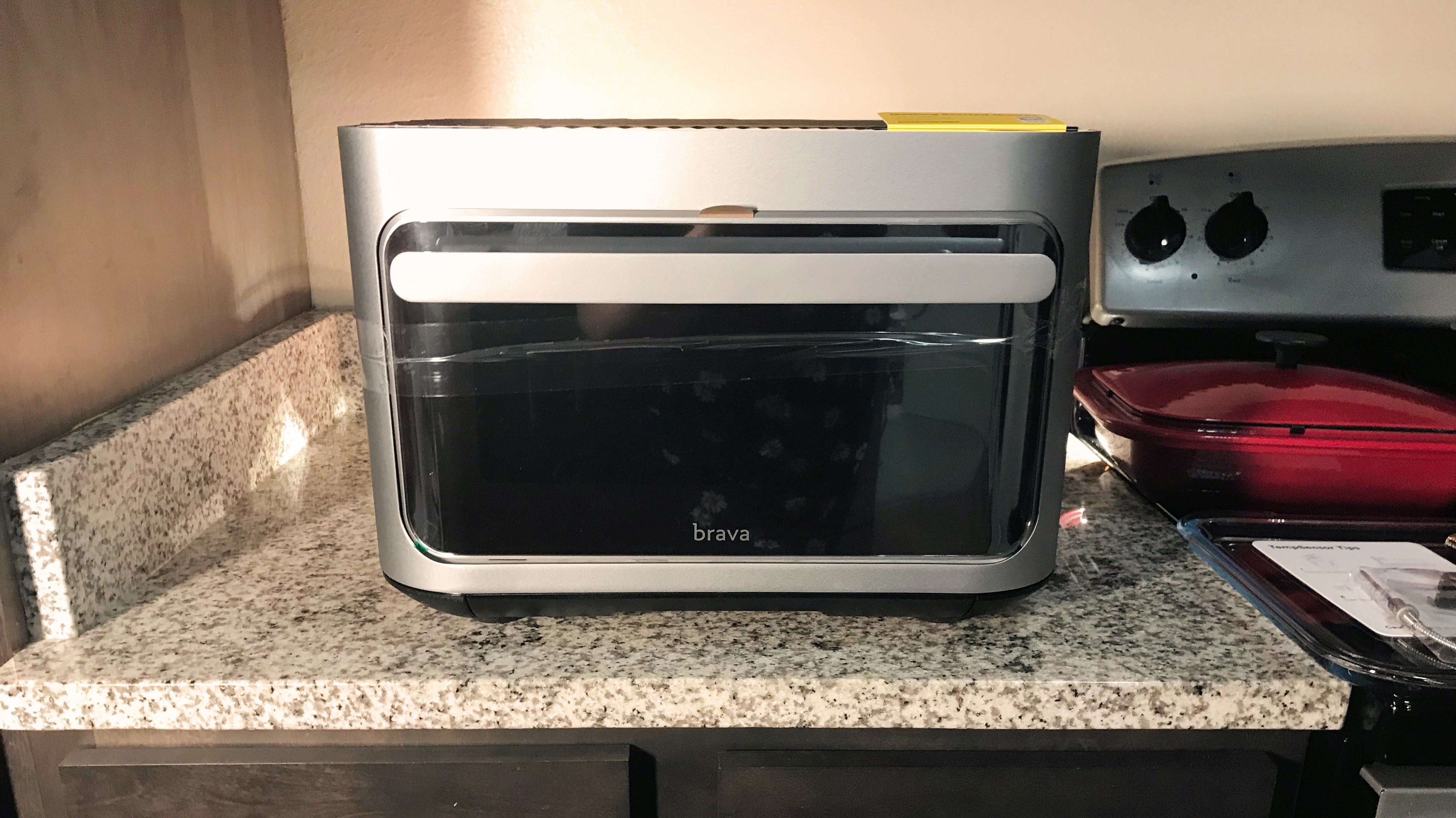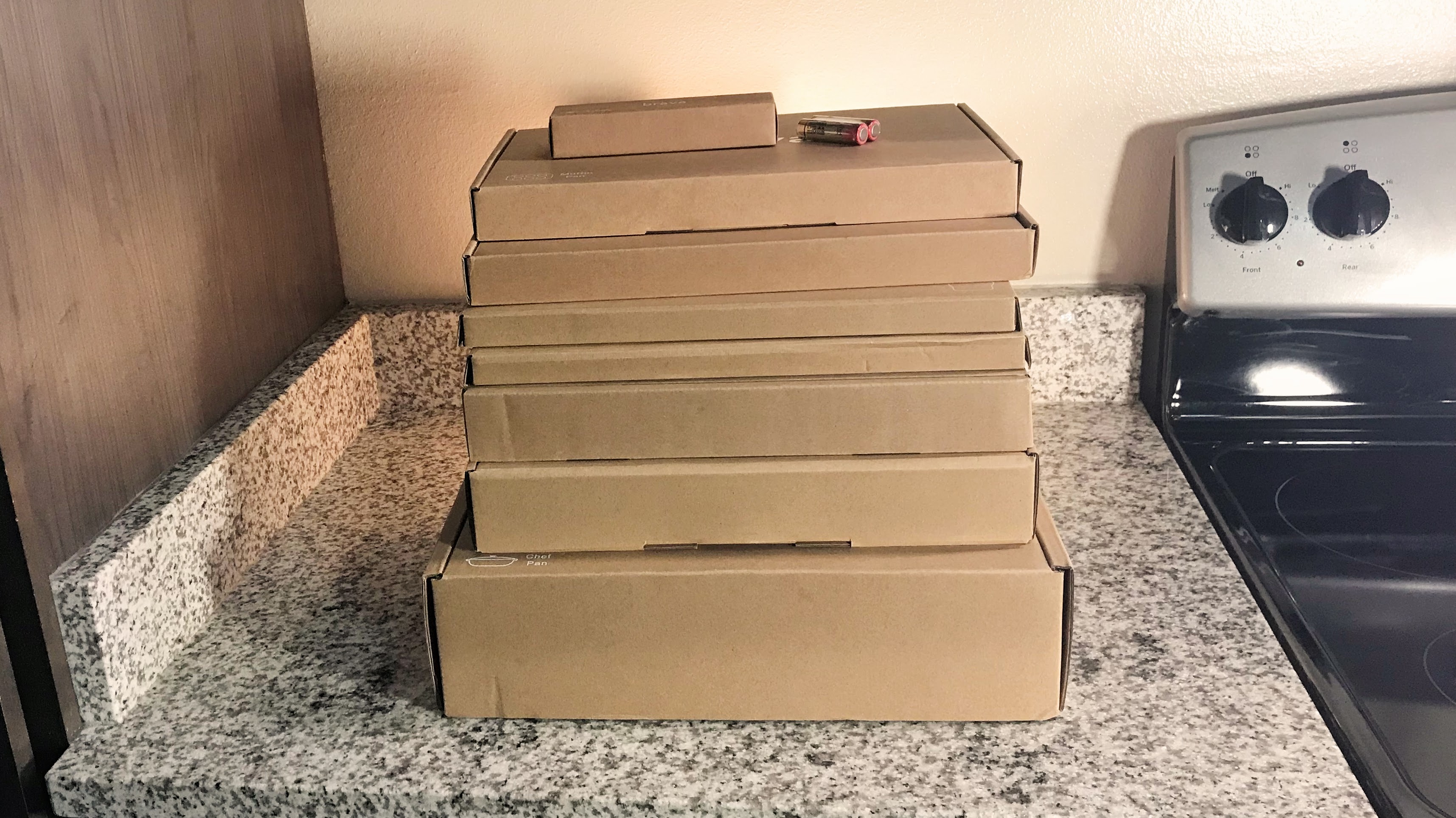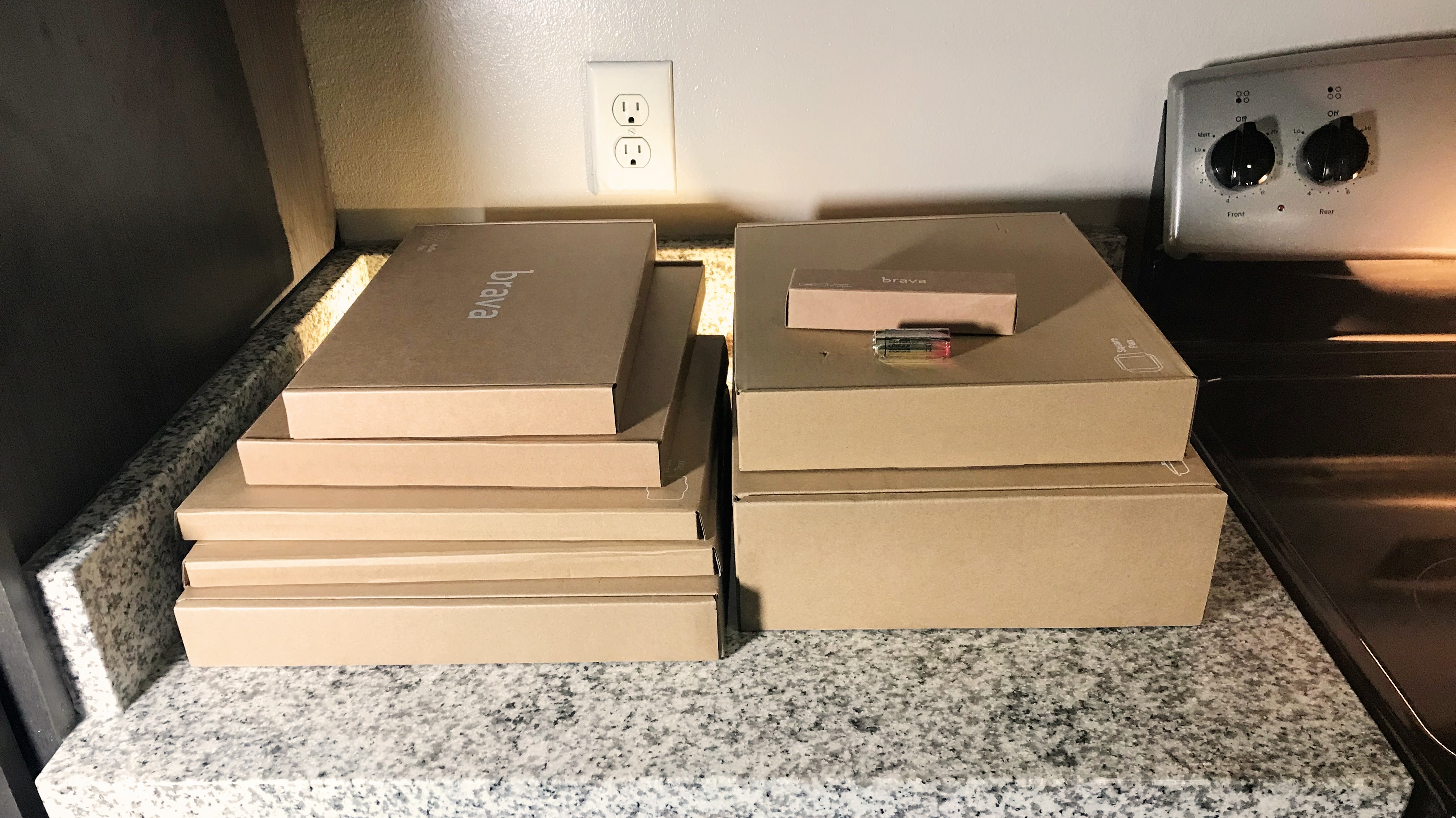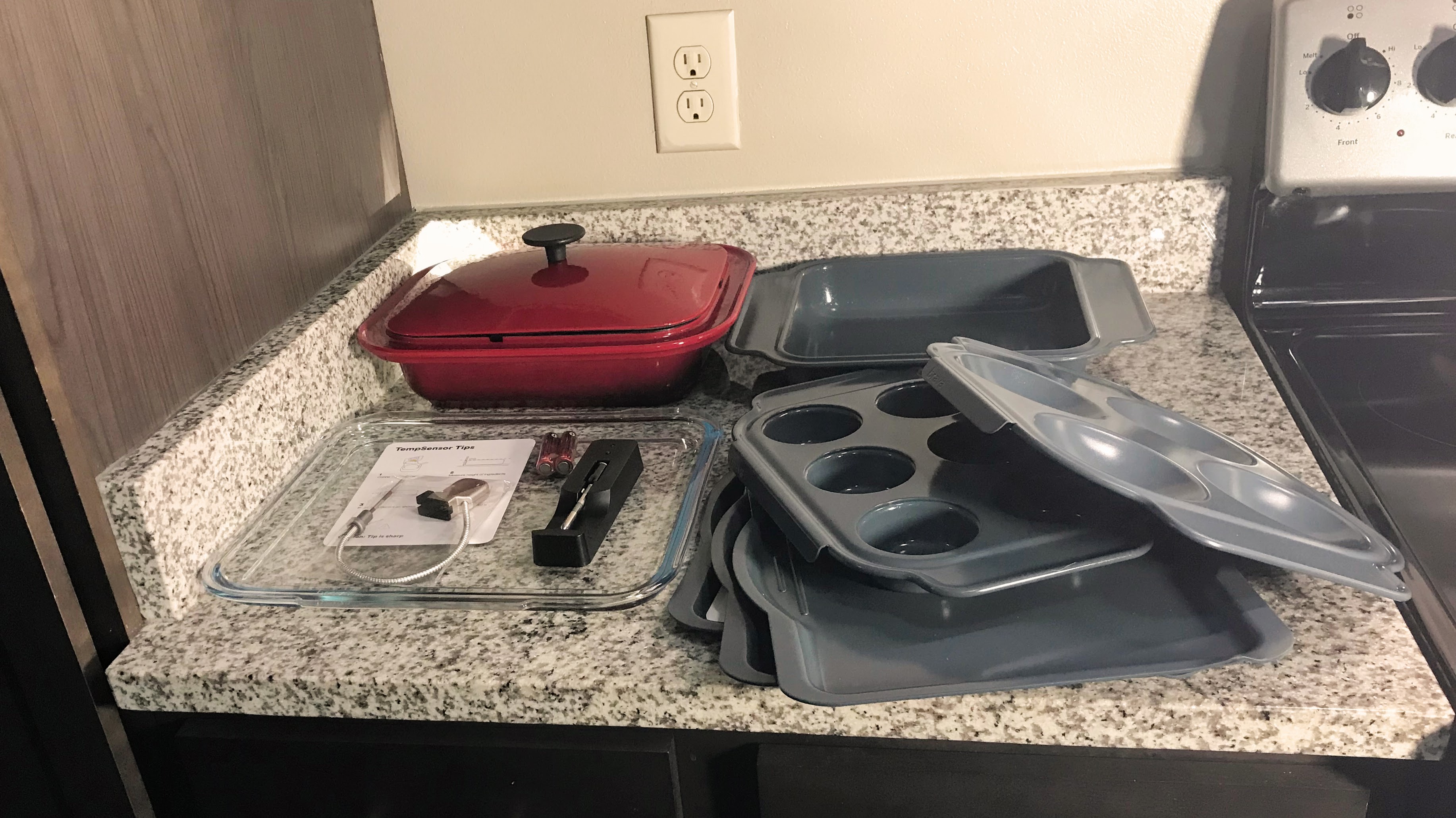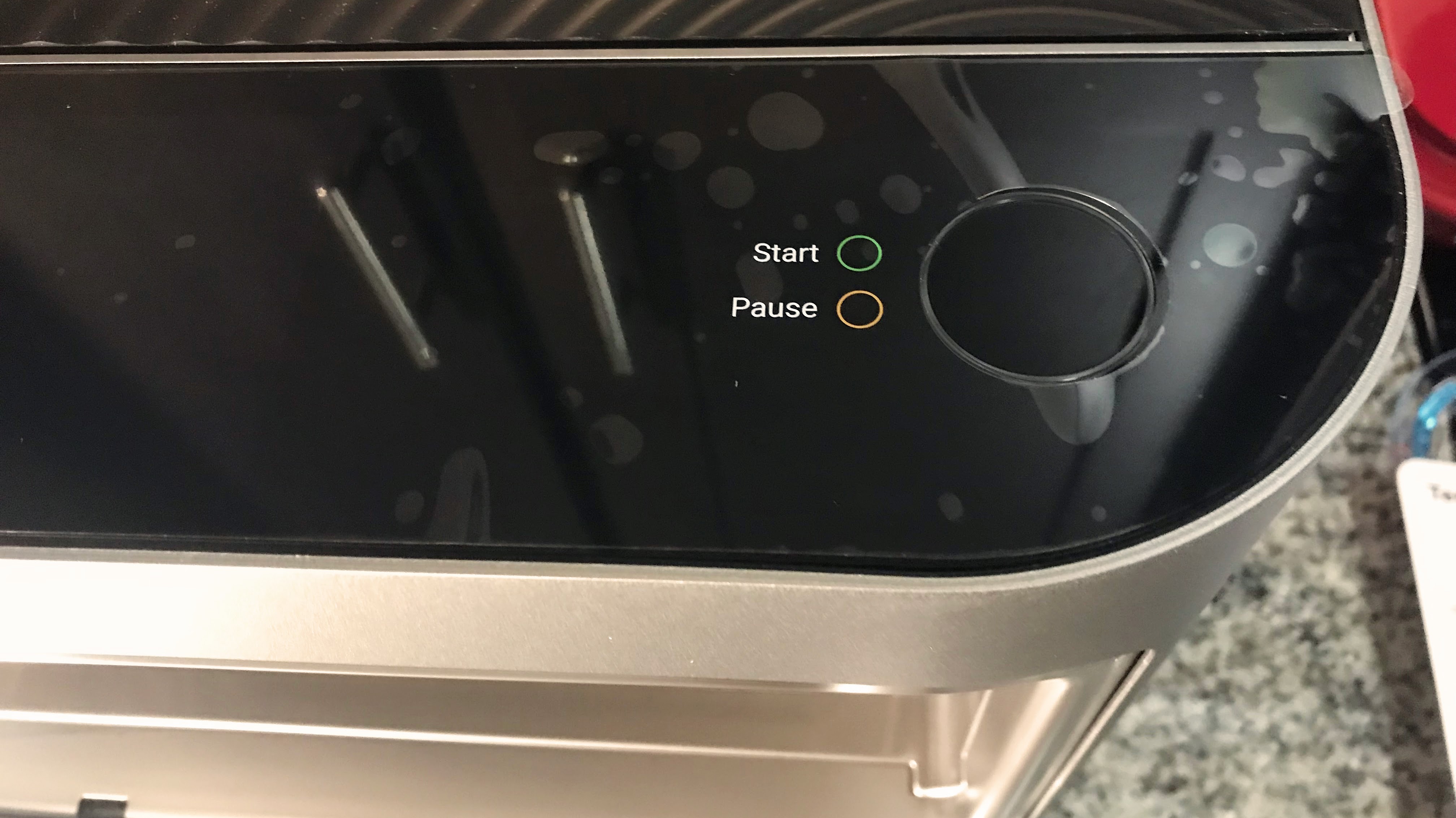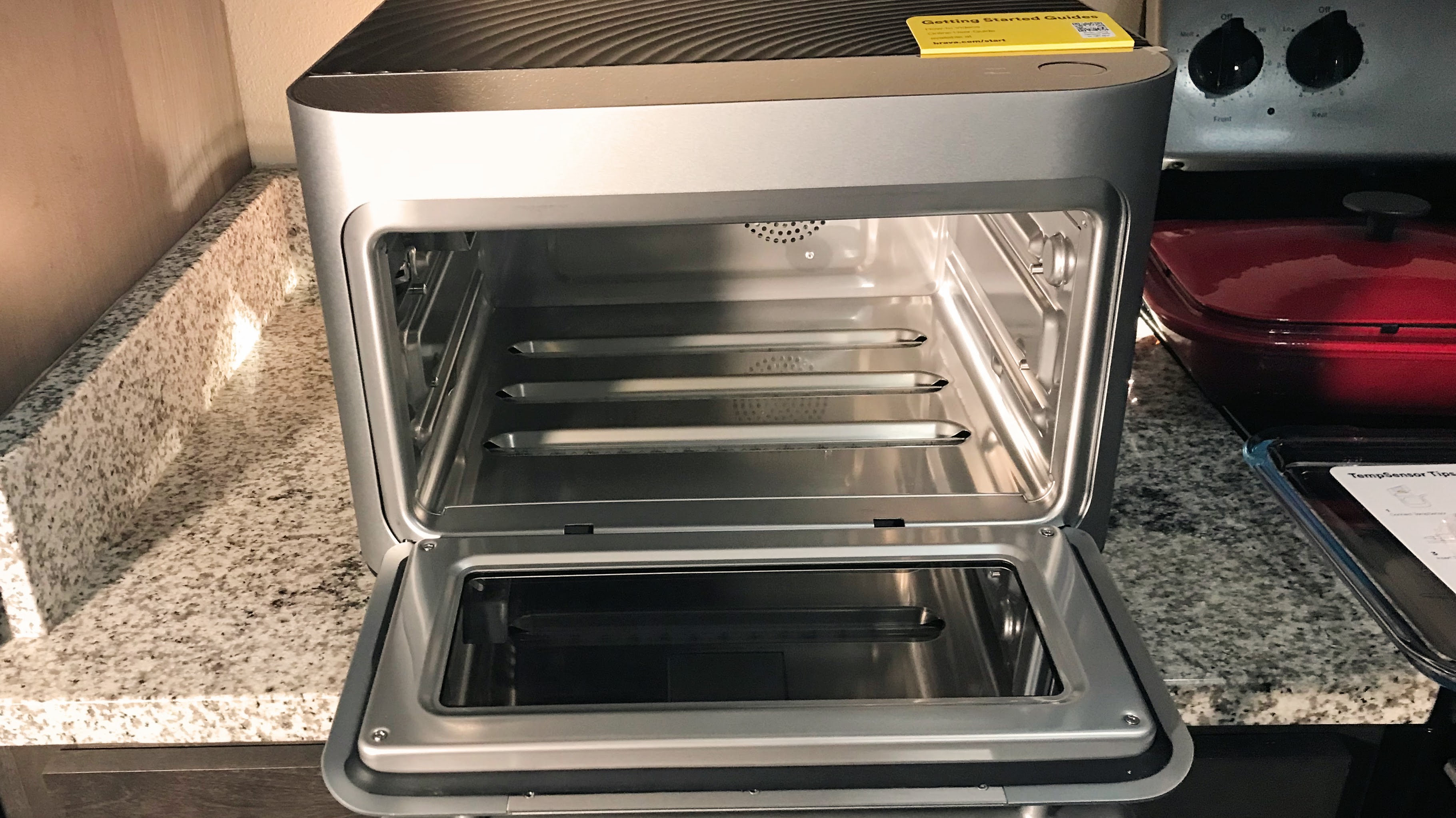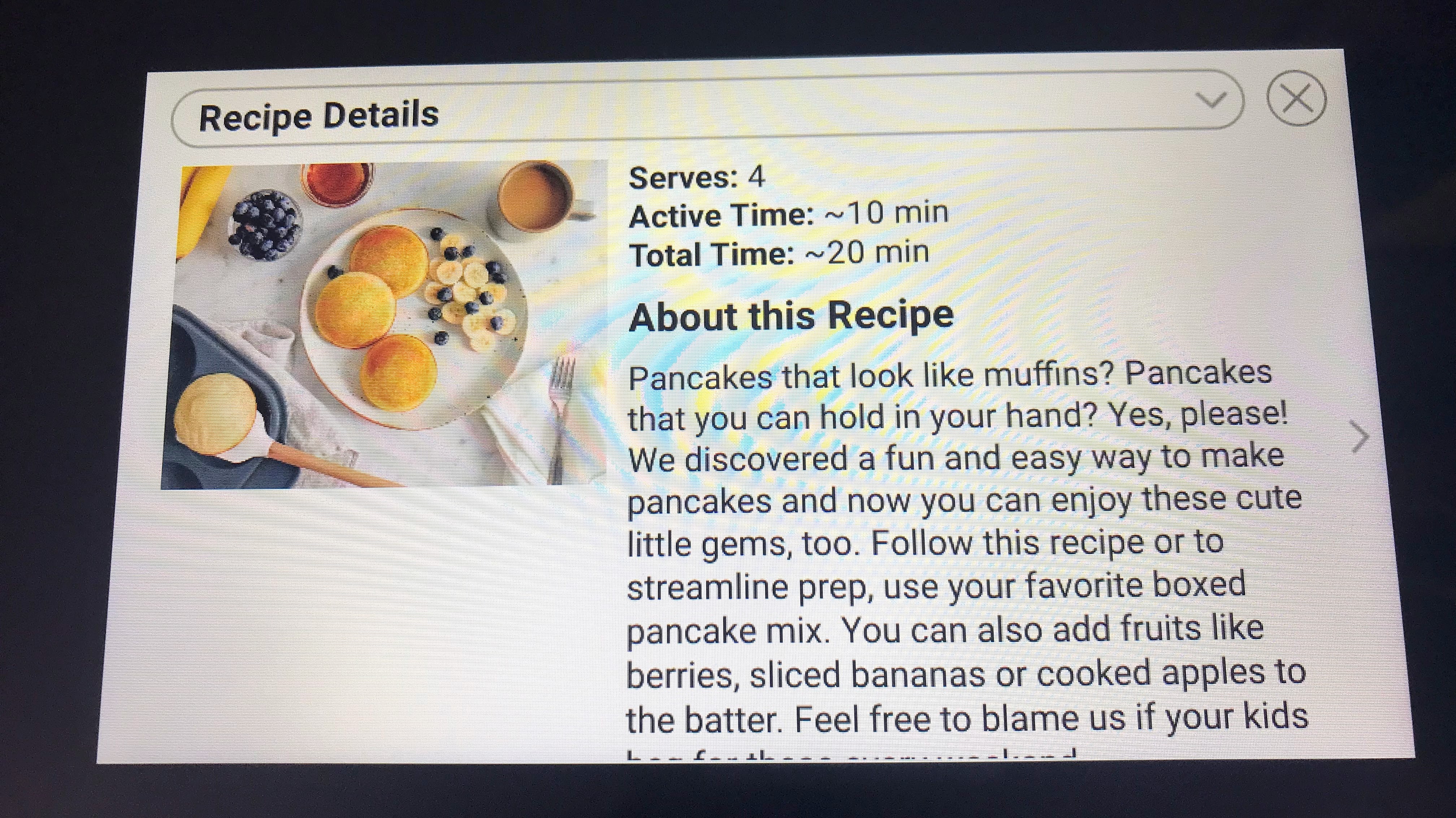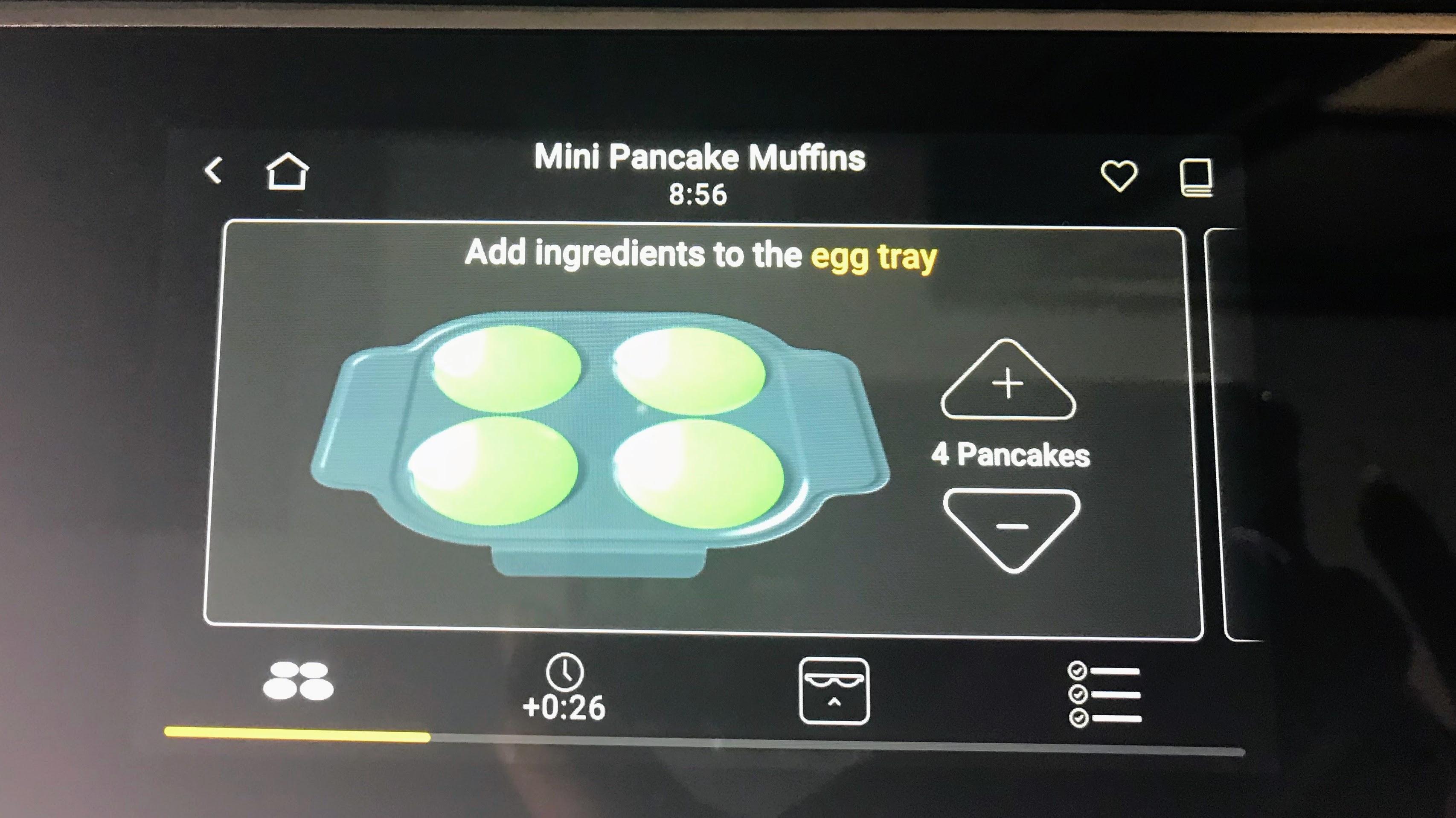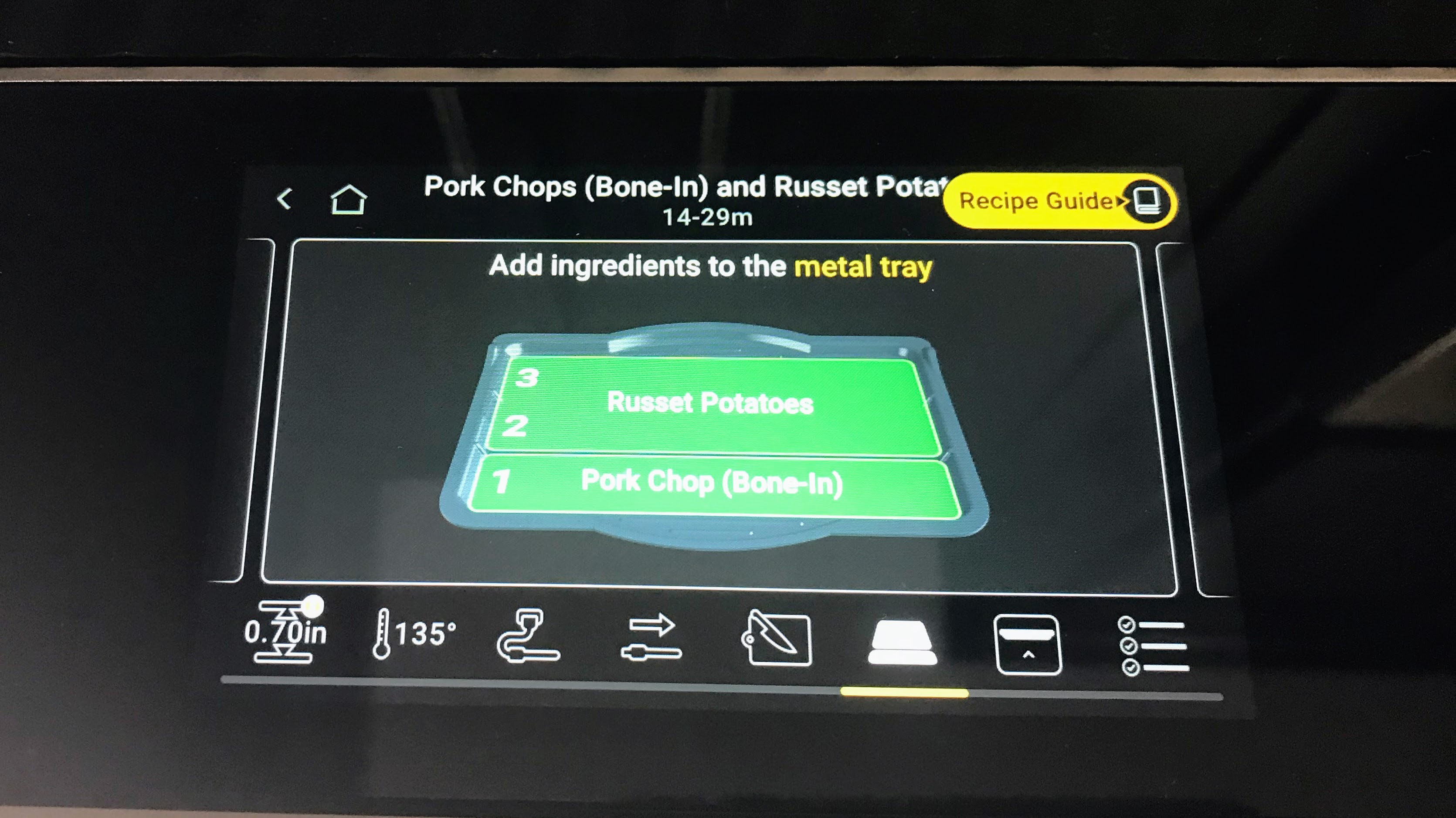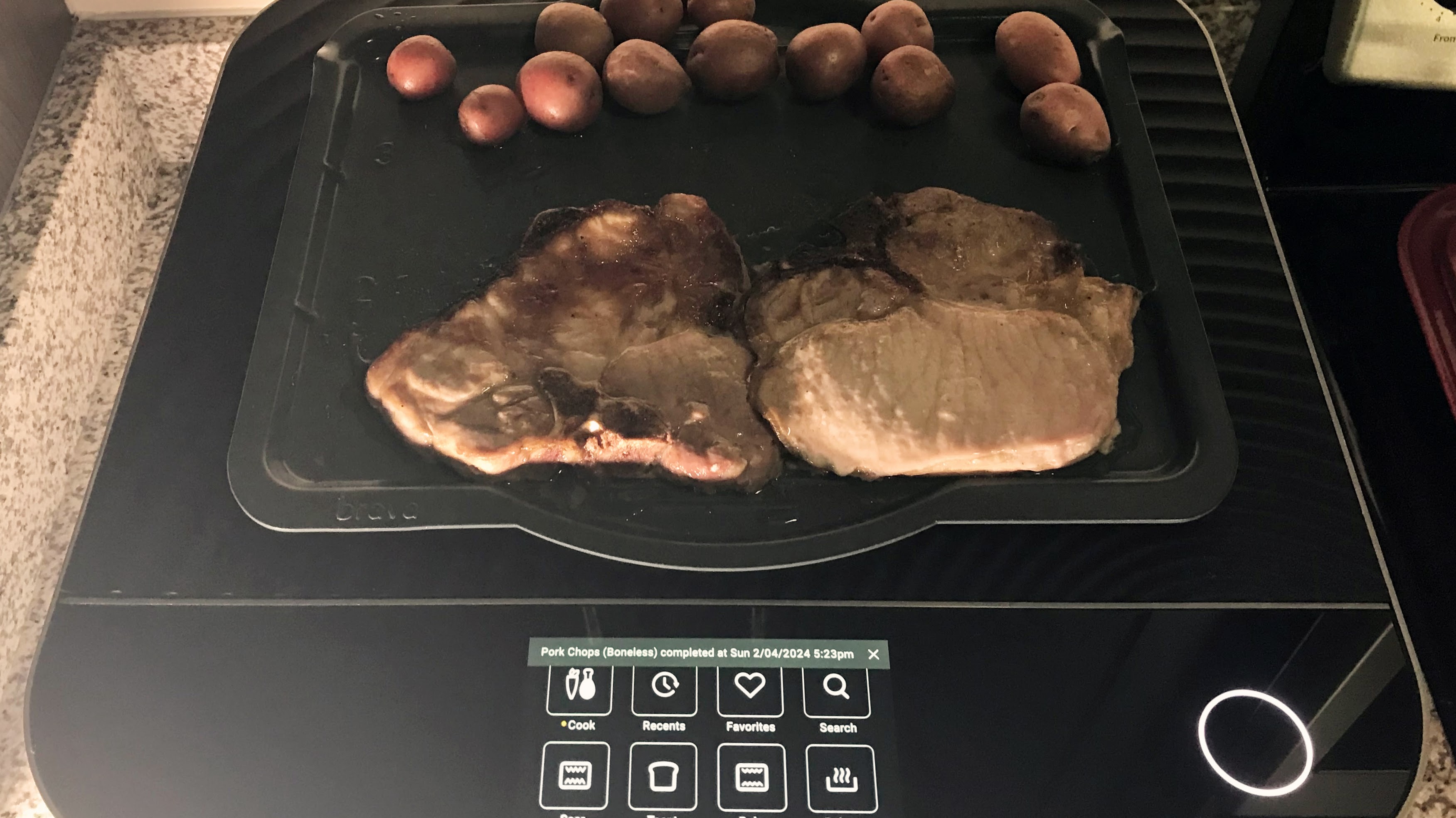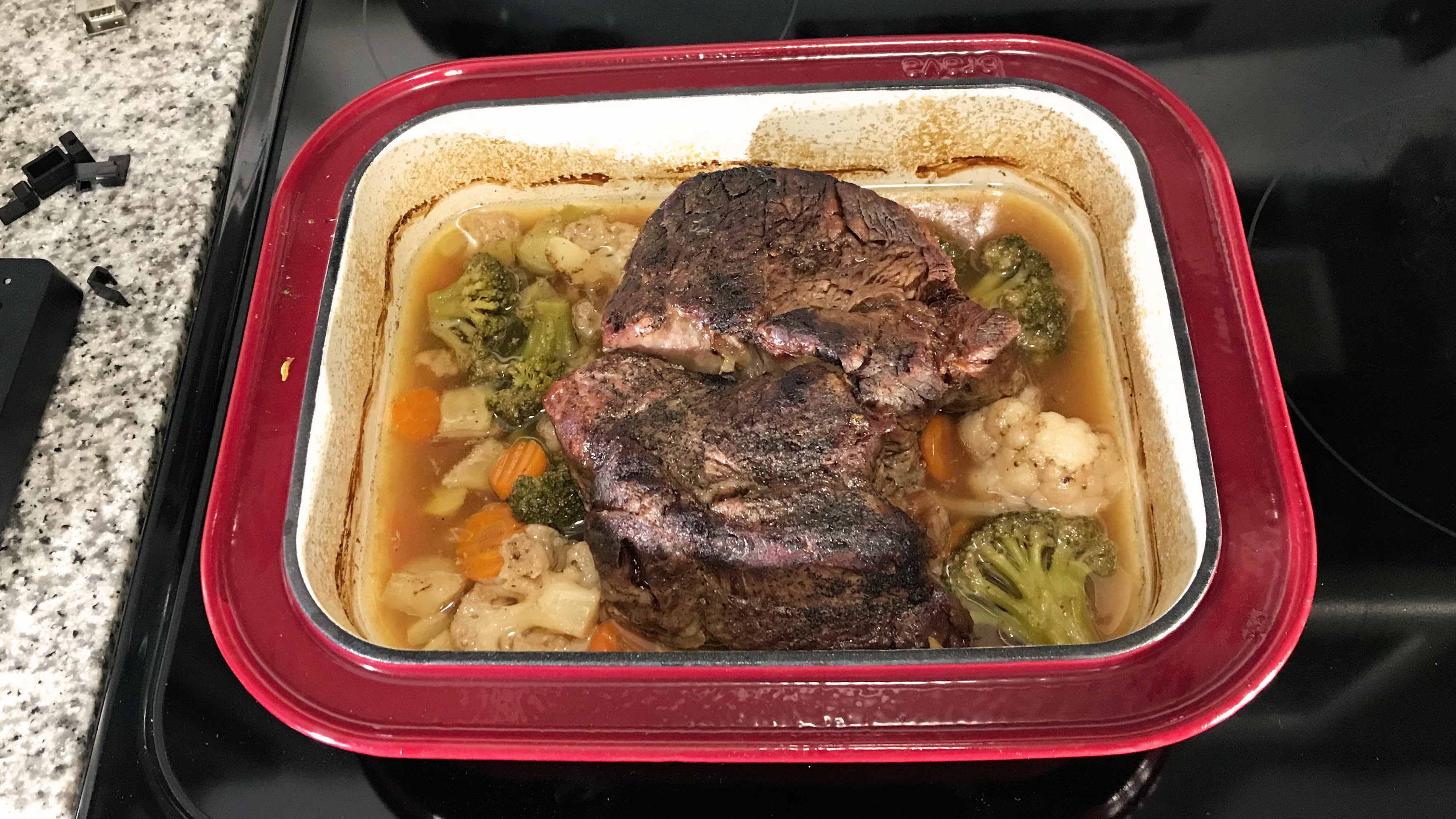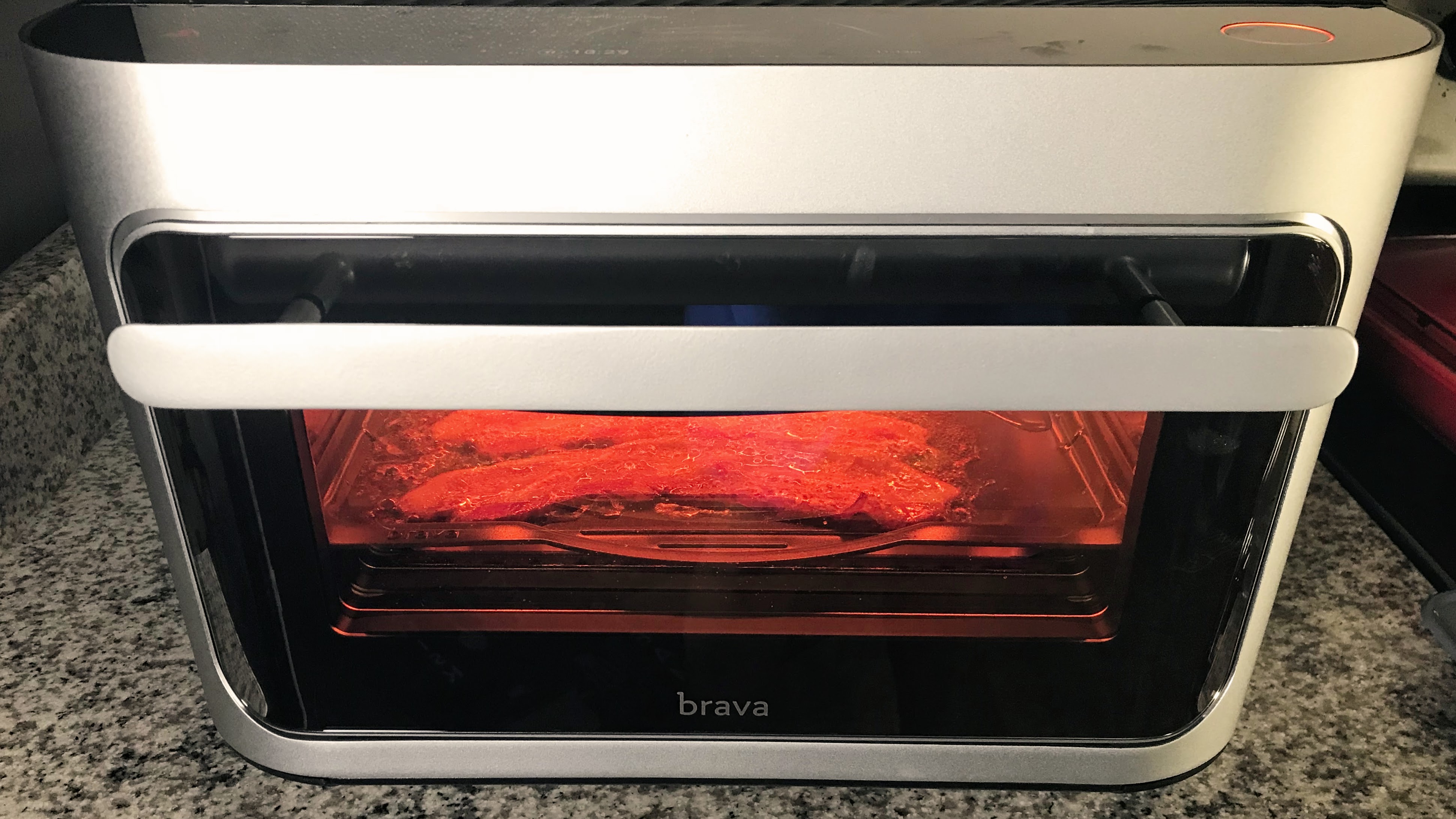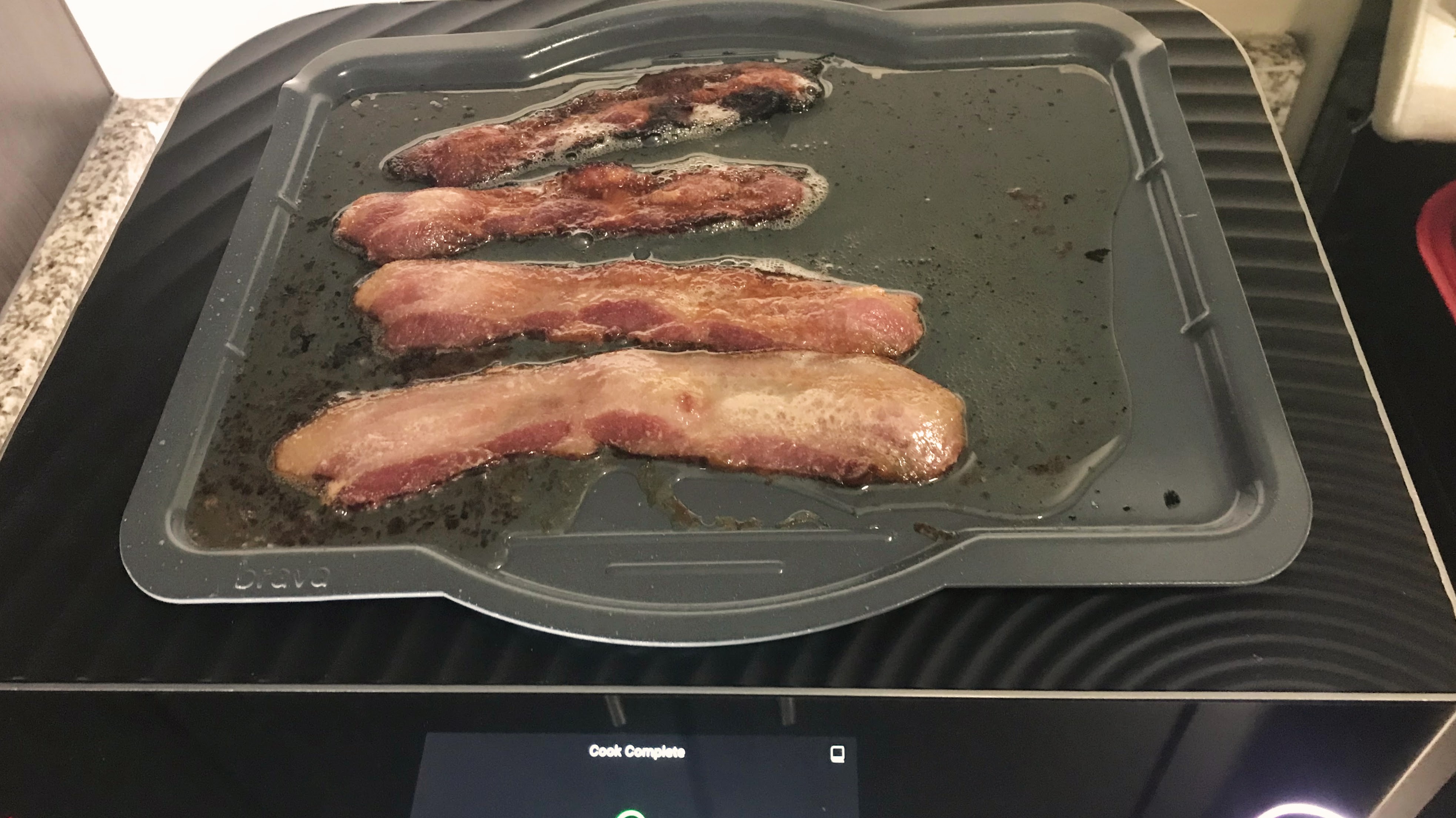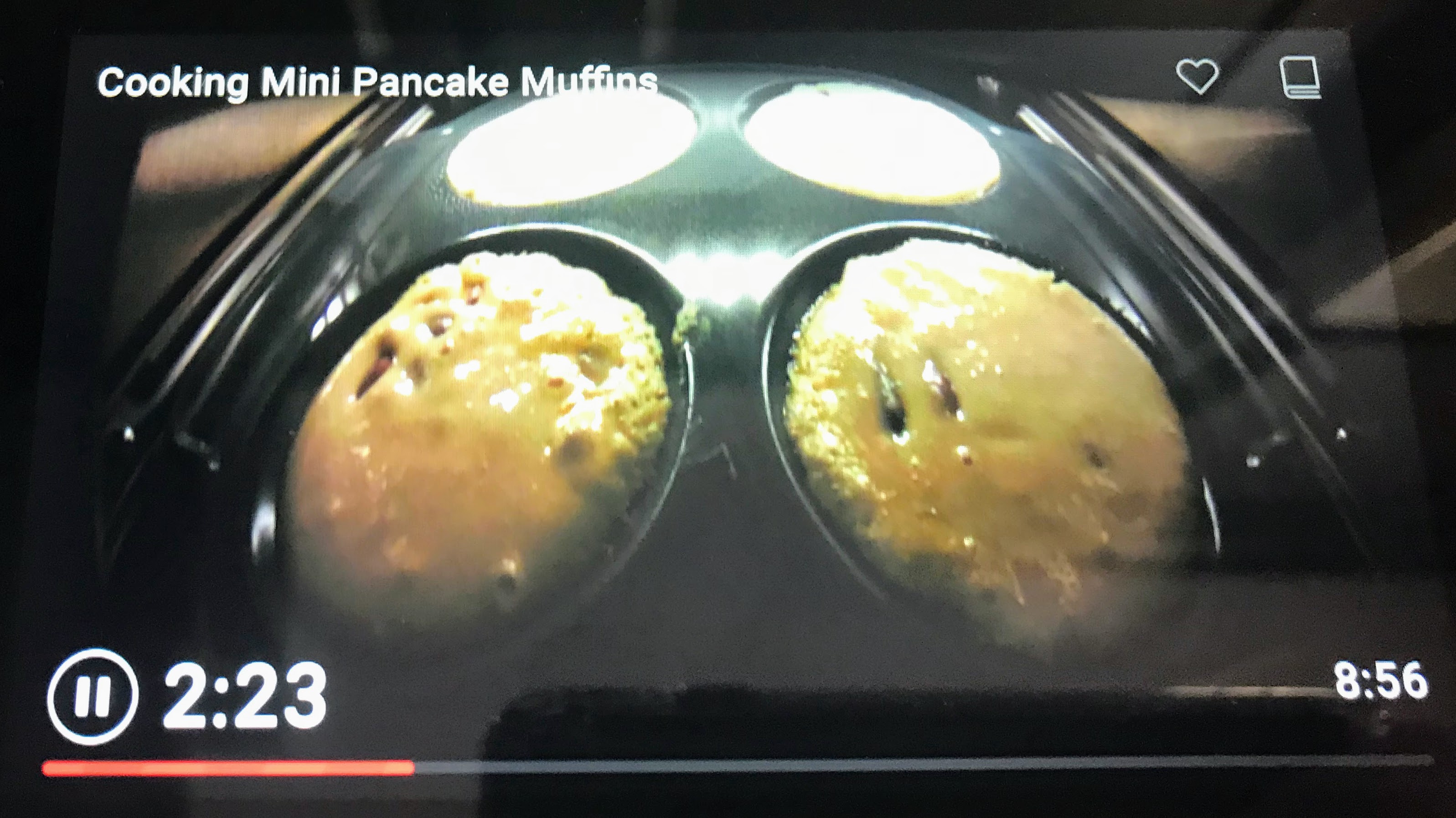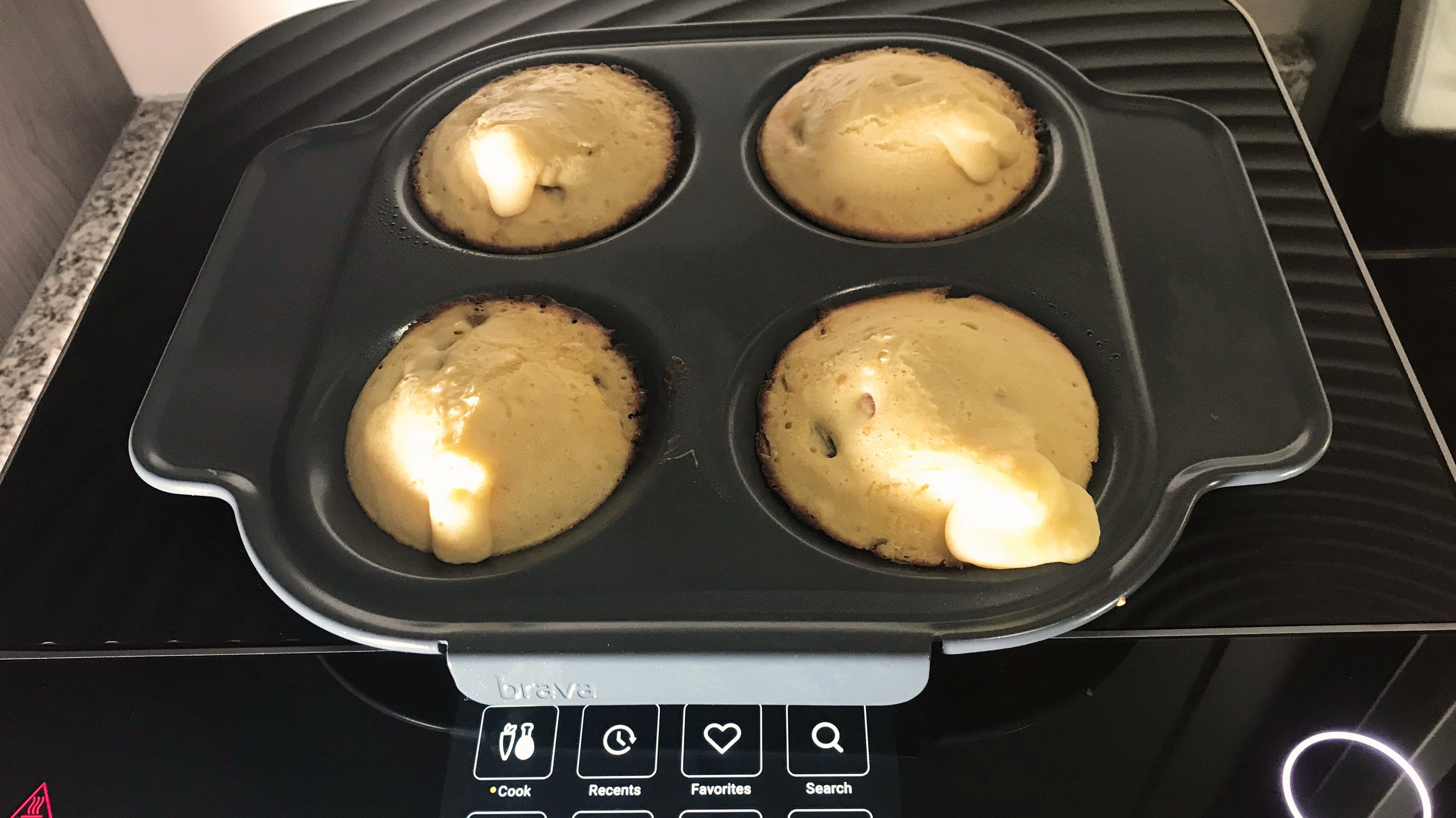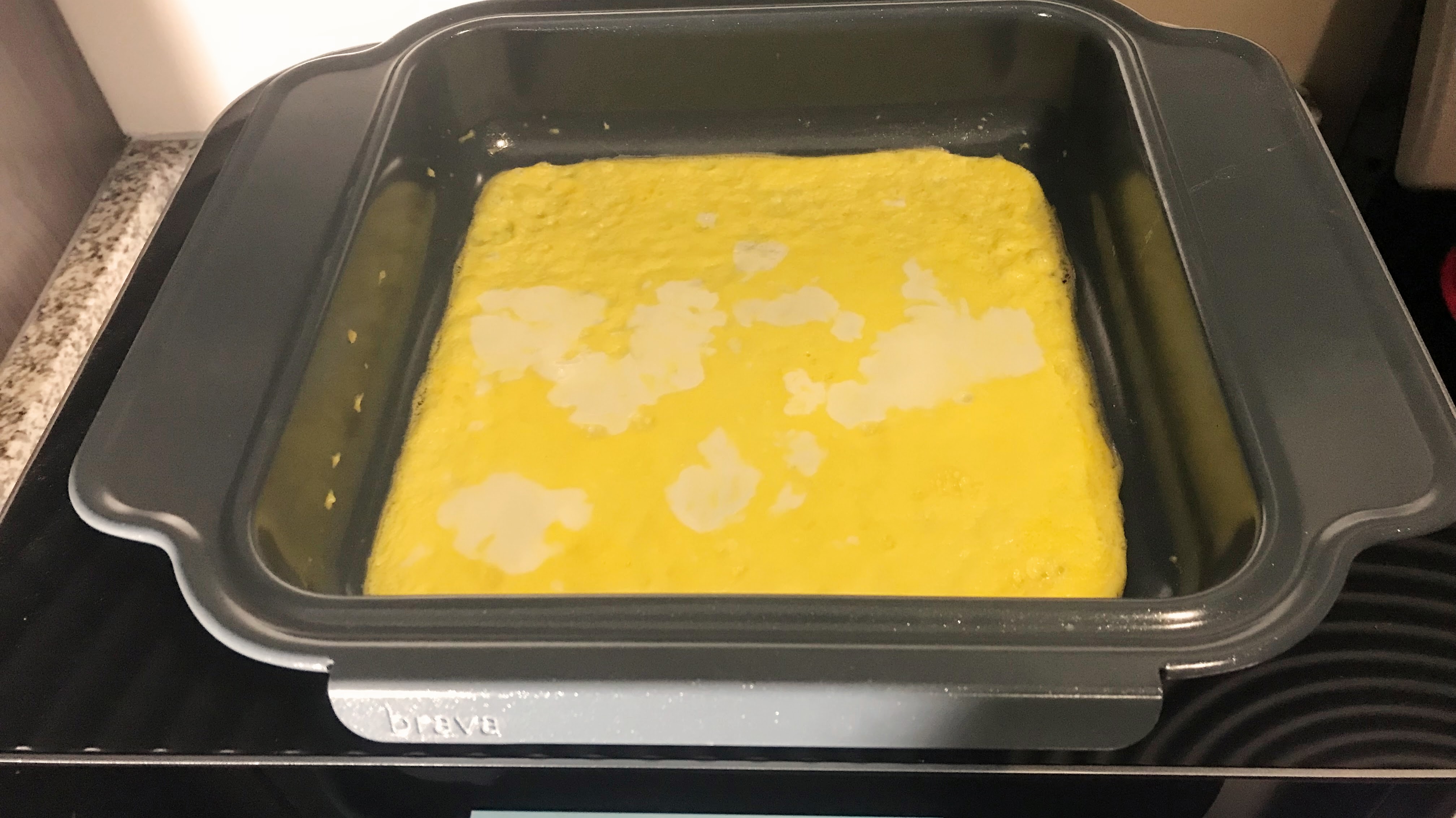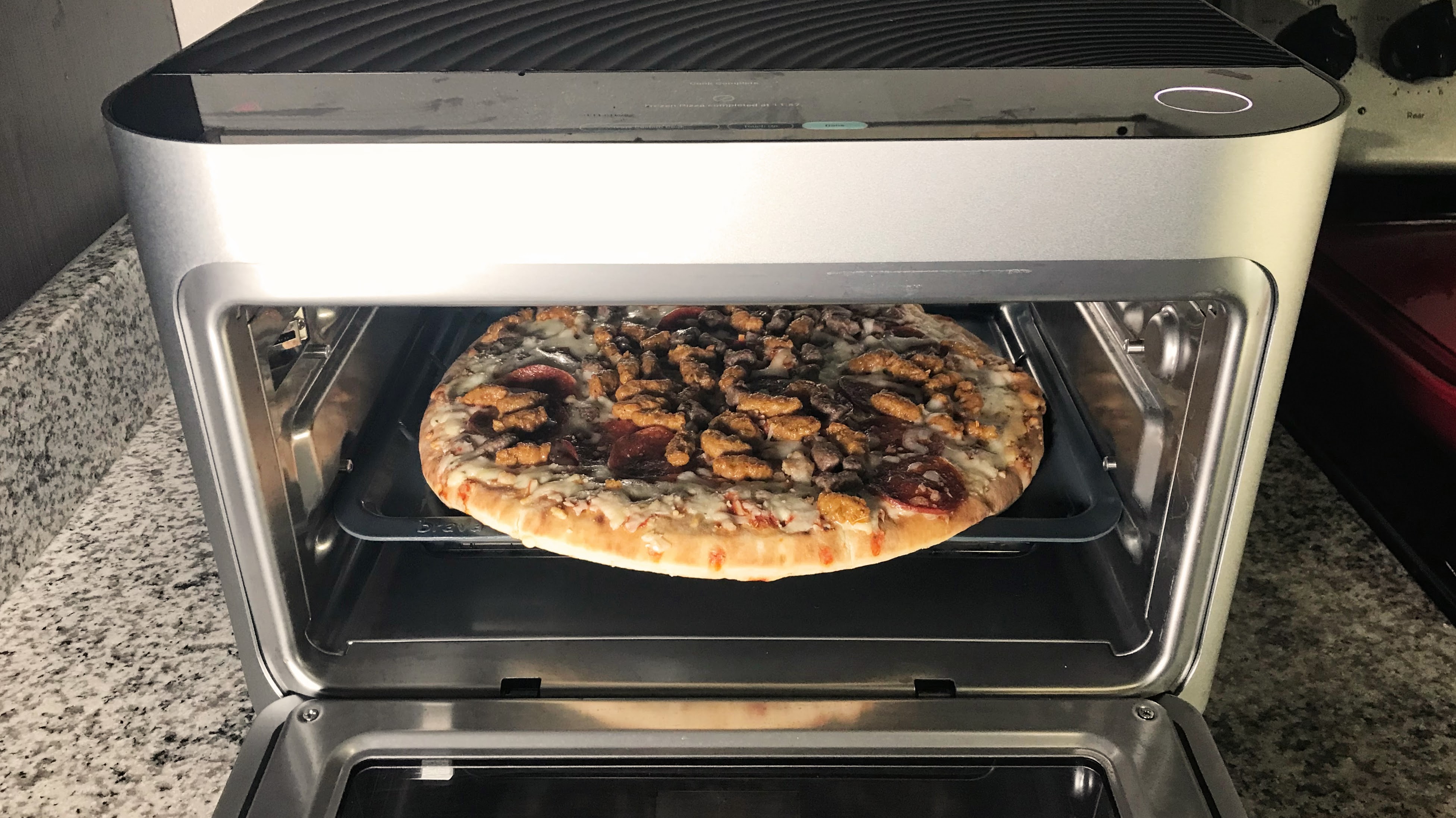The Brava Glass Oven is an update to the original Brava Oven, which – as you might have deduced – does not have a glass door. This new model also has a wireless temperature sensor, a lifesaver for those who hate fidgeting with wired sensors. The original Brava Oven has two cook trays (glass and metal) and a wired temp sensor. There’s also the option to upgrade to the Bake & Breakfast set, which includes more trays and several pans, or the Chef’s Choice, which includes all of the aforementioned in addition to the Chef’s Pan/Dutch oven. The Brava Glass Oven includes all the accessories you would get with the Chef’s Choice option.
Brava is a high-end countertop oven (with a price tag to match). It’s several hundred dollars more expensive than the June Oven Premium (another of the most expensive countertop ovens on the market—currently out of stock). However, the ridiculously high functionality allows Brava (and June) to occupy such a top-tier status.
The Brava Glass Oven has many of the features of the regular Brava Oven. One important difference is that the Brava Glass Oven has a clear glass front (like most countertop ovens), allowing you to see the food as it cooks. Ironically, I thought this was the most unimpressive feature because the door handle blocks me from seeing anything if my food is on the upper tray.
A wireless temperature sensor is a practical addition to the Brava Glass Oven. The original Brava already has a wired temperature sensor, but it’s convenient to have both. Otherwise, the features I describe are available on the original Brava and the Brava Glass Oven. Keep reading to see how I fared when testing the Brava Glass Oven, and head to our best air fryer and best toaster oven guides for more.

Terri is a freelance writer living in Birmingham, AL. She has tested hundreds of products, including kitchen appliances, vacuums, bedding, furniture, luggage, and tech gear. Terri has bylines at Architectural Digest, Forbes, Popular Science, CNN Underscored, NBC News, The Daily Beast, USA Today, US News & World Report, Tech Radar, Homes & Garden, and Tom's Guide. Follow her adventures @Territoryone.
Terri has tested several countertop ovens, including June, Breville, Tovala, Ninja, Wolf, and De’Longhi. She tested the Brava Glass Oven for several weeks, evaluating its design, user-friendliness, and performance. Terri was allowed to keep the countertop oven for ongoing use.
Brava Glass Oven: Key specs
| Row 0 - Cell 0 | Row 0 - Cell 1 |
| Capacity | 3.5 quarts |
| Functions | 10 (air fry; roast; bake; sear; toast; reheat; rice; dehydrate; slow cook; keep warm) |
| Power | 1800 watts |
| Dimensions | H13 x W16.3 x D15.9 inches |
Brava Glass Oven: Price & availability
The Brava Glass oven is $1,995. It’s available on Amazon and the Brava website. It’s incredibly expensive, and I never see it on sale. However, it’s difficult to compare it to other countertop ovens because nothing else on the market does what the Brava Glass Oven does.
Brava Glass Oven: Setup
The Brava Glass Oven was boxed well for the shipping process. When I opened it, I was pleasantly surprised that it was not a big, bulky, heavy machine.
The oven comes with many accessories, including three metal trays, which are used for anything you would use a skillet for (most meats, potatoes, veggies), and the glass tray for fish, dehydrating, and lightly roasted vegetables. There’s also an egg tray, muffin tin, loaf pan (although I don’t have a loaf pan), chef’s pan (Dutch Oven), wired temp sensor, wireless temp sensor – and even batteries for the latter. The oven requires a dedicated electrical circuit and a 20 AMP circuit breaker.
The Brava Glass Oven uses cool-surface technology, so touching the exterior sides is not hot. However, Brava does recommend clearance around the back for ventilation, so the oven should not be built into a cabinet.
When the door is opened, the oven automatically pauses. This is a definite benefit. I see it as a safety feature; also, it prevents the recipe's timing from being thrown off (it didn’t cook properly for 15 minutes if the door was open for 2 minutes). However, you must press the start button again when closing the door. If not, the oven will remain in pause mode.
The Brava Glass Oven creates heat using six pulsating lamps that can deliver searing power in just a few seconds and cool off quickly. These light pulses are designed to cook food faster and more precisely. There are two lamps (one at the top and one at the bottom) in different zones (zone 1, zone 2, zone 3). Each set of lamps focuses on its particular zone. For example, I can put steak in one zone, small potatoes in one zone, and asparagus in the third zone, and each food type will cook at the best temperature.
The fan turns on whenever I finish cooking. This protects the wiring and controls from overheating, and it also serves to prepare the oven for the next cooking cycle.
After unboxing everything, the next step was to connect the oven to my network. The software began updating when I downloaded the Brava App on my phone. When the display screen is not in use, various recipes appear. I can also search for specific recipes. There are so many recipe types to choose from. For example, I can search by sweets, chef’s picks, two-tray cooks, sides, dairy-free, bread, and frozen foods - the possibilities appear endless.
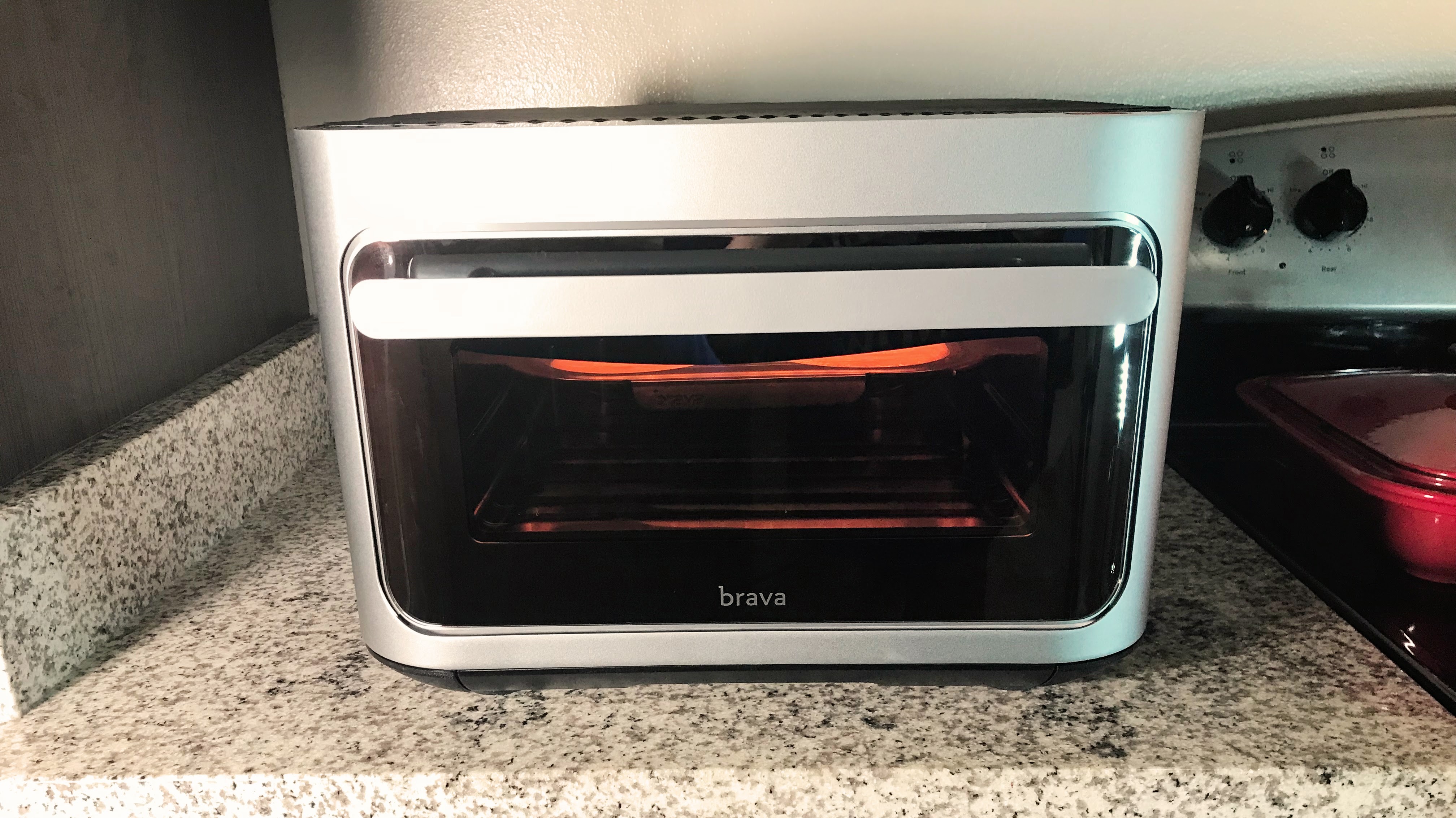
Brava Glass Oven: Design
The oven weighs 34.4 pounds, so it’s not particularly heavy. The dimensions (16.3W x 15.9D x 13H inches) make it a compact machine that doesn’t take up a lot of space on the countertop. The Brava Glass Oven has an anodized aluminum finish on the outside, and the interior has a stainless steel finish. It’s a stylish countertop oven. The glass door is easy to open and shut and never sticks.
A (removable) heat-resistant silicone mat is on top of the oven, which is convenient for placing hot trays and pans on when taking them out of the oven.
The 5-inch diagonal multi-touch display on the top of the Brava Glass Oven uses IPS technology. It’s a color display with 854 x 480 native resolution, and has a 180-degree viewing angle. The 5-megapixel camera streams the internal cooking chamber (and fortunately, it resists grease and heat).
Score: 4.5/5
Brava Glass Oven: Performance
I thoroughly enjoyed the guided instructions, which take the guesswork out of cooking. When using the Brava preset recipes, the instructions tell me which tray to use, what food to place in which zone, and which shelf to place the tray on. For example, one of my tests was making mini pancake muffins in the egg tray. The instructions on the display screen walked me through the process. It directed me to use an egg tray and told me which shelf it should use. Although it’s a preset, I always have the option to increase the time and quantity.
And then, I could see the mini pancake muffins cooking in the Brava Glass Oven on the display on top. However, since they were on the top shelf, I could not see them through the glass door because the door handle partially blocked my view—which seems to negate the benefit of having a glass door.
In fairness to Brava, users have long complained that the original Brava Oven didn’t have a glass door – since most countertop ovens do. So, Brava may have added the glass to the Brava Glass Oven to quiet those critics. However, I greatly prefer viewing my food’s progress via the camera using the display on top.
Next, I made pork chops with Russet potatoes. I chose a preset, which instructed me to use a metal tray, place the pork chops in zone 1, and put the russet potatoes in zones 2 and 3. The chops cooked rather unevenly, but the potatoes were fine. I extended the cooking time, and the chops reached a better level of doneness.
However, one concern with putting the veggies and pork chops on the same tray is that the oil from the pork chops makes the potatoes oily. Another concern is Brava’s quantity recommendations for achieving perfection. For example, I couldn’t just toss a handful of potatoes in the zone. The recommendation is to fill the zone (without overfilling – and there are images to show you what the perfect fill looks like) – so I always ended up cooking more potatoes than I could eat then. Granted, since I had two pork chops, I was able to eat one pork chop with potatoes on one day and the 2nd pork chop with potatoes on the next day.
The metal and glass trays are rather shallow, so I needed to be very careful when removing meat items that produce a lot of oil, like pork chops and bacon.
Setting the tray or pan on the Brava Glass Oven (on the silicone mat) is a game-changer. I don’t have to search for trivet mats, and I don’t have to take up valuable countertop space.
On another day, I fried eggs in the egg pan. I also fried bacon on the bottom tray, visible through the glass oven since the door handle doesn’t hide it. I took the eggs out so you could see the bacon. Note: I don’t eat fried eggs (I only did that test for you, dear readers, to show you that it’s easy to make them in the muffin pan). However, I made scrambled eggs (with milk) in one of the metal pans, and I can tell you that they were yummy. When cooking the bacon tray, the two slices in the back were done before the rest, so I took them out before they burned and then put the tray back in to let the remaining bacon cook.
I also baked refrigerated Nestle chocolate chip cookies on my own (using the Baking feature) since this is not in the recipe gallery. Preheating is required when using the Baking feature, but the oven got hot quickly, and there’s a countdown timer to let me know how long the preheating process takes. The cookies were baked to perfection—crunchy on the outside and gooey on the inside.
I also tossed a frozen Walmart-brand pizza into the Brava Glass Oven. The crust was crispy, the cheese was gooey, and the other toppings were delicious.
My final test was to make a chuck roast in the Chef’s Pan/Dutch Oven. Full disclosure: the Dutch Oven is quite heavy, and the Brava Glass Oven’s interior is quite small, making it rather difficult to pull the Dutch Oven out to view the cooking progress (and I couldn’t rely on the camera since the lid was on the Dutch Oven). So, I poured as much water as I thought it would need to cook the chuck roast without taking it out and checking the progress. As a result, my veggies looked more like they belonged in soup. However, the chuck roast was tender, juicy, and easy to cut. While it was delicious, I’ll stick to using the Dutch Oven in my regular oven, where I have more clearance.
The Brava Oven also has a Custom Cook option. For example, I could add a Sear step (which I did several times) or create a recipe from scratch.
There are a few things to note about the Brava Glass Oven. You don’t have to connect to the Internet to use the oven. However, you won’t get updates to the preset recipes, and you can’t monitor the food remotely. Also, Brava is very particular about specs when cooking food. So, if the instructions are to cut the potatoes into 1-inch segments, and you cut them into 2-inch segments, you might not get the same results.
Also, as I mentioned earlier, Brava likes to fill the tray, so you can’t just throw a handful of veggies in a zone. If that zone is underfilled, the food may be overcooked. And if you overfill the zone, some food may burn.
In addition, if you’re substituting foods for a recipe, it calls for broccoli. Still, if you don’t want to use broccoli, it’s best to substitute something comparable in size and color, like asparagus. However, Brava warns that, for example, small potatoes are not a good substitution.
Here’s something else to keep in mind. Brava may provide a cook time and then tell you the food is done in half the time. Admittedly, the Dreo Chefmaker does this as well. However, with the Dreo, the food is done, whereas with the Brava, the food is not (although the thermostat may tell you it is). In this case, the touch-up option will add more cooking time.
There’s not a steep learning curve for using the Brava Glass Oven, but there is a learning curve for perfecting the use of the oven. Expect trial and error while figuring out how to get the best results. However, once you get the hang of it, it’s truly a delight to use it. It’s also quiet, and I can barely hear it working.
Score: 4.5/5
Brava Glass Oven: Maintenance
Regarding cleaning, Brava recommends using non-toxic wipes like Seventh Generation wipes or a non-toxic spray with paper towels or microfiber cloths. After each use, I used slightly damp paper towels to clean the glass door and the chamber.
After each use, I wiped the camera with a paper towel (folded over for bulk).
Brava recommends Astonish oven cleaner or Bar Keepers Friend (in liquid form) for deep cleaning.
Fortunately, the lamps clean themselves during the cooking programs, so I don’t have to manually clean them.
There’s also a crumb tray at the bottom of the oven. I slide it out and clean it with soap and water every few cooking cycles.
Should you buy the Brava Glass Oven?
| Attribute | Notes | Score |
|---|---|---|
| Price & availability | Expensive but impressive | 4/5 |
| Design | Intuitive | 4.5/5 |
| Performance | Very good but learning curve to perfect | 4.5/5 |
Buy it if...
Don’t buy it if...
How does the Brava Glass Oven compare?
Another Smart Oven option is the June Oven, which provides guided instructions on the front panel. It also has an app that lets you preheat the oven and adjust the time and temperature remotely. The June Oven also has an internal HD camera to let you see inside the oven via your smartphone or tablet. However, it does not provide a camera view on top to let you stand at the oven and view the contents (although you can see through the glass door). The June Oven is $899, the June Oven Plus is $999, and the June Oven Premium (comparable to the Brava Glass Oven in accessories) is $1,299.
If you need a larger oven that can cook two items at different temperatures simultaneously, consider the Ninja 12-in-1 Double Oven with FlexDoor. It can cook two foods at different temperatures and be synced to finish simultaneously. The Ninja 12-in-1 Double Oven with FlexDoor is $249.
How I tested the Brava Glass Oven?
I tested The Brava Glass Oven in my home for several weeks. Regular use allowed me to assess the quality of the build and ease of use, as well as performance and cleaning.
I cooked various foods, from frozen pizza to fresh meat to veggies to eggs and cookies, and I also used several cooking modes to see how the oven performed.
Read more about how we test.
